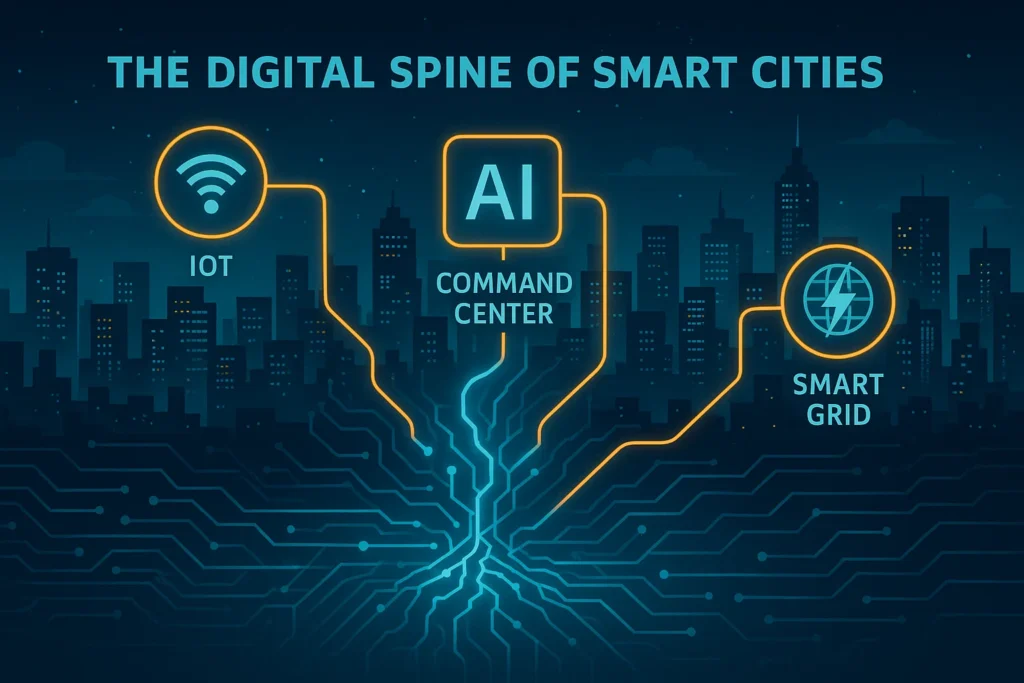Introduction: The Urban Revolution You Can’t Afford to Ignore
Smart Cities in India aren’t just a concept anymore — they’re a necessity.
India’s cities are bursting at the seams.
Traffic jams stretch longer than a Netflix binge. Garbage mountains rise like unwanted tourist spots. And don’t even get us started on water shortages.
But in this chaos, there’s a quiet revolution underway — one that promises not just smoother lives but also smarter investments.

Welcome to India’s Smart Cities Mission — a ₹98,000 crore transformation plan that’s reimagining how urban India lives, breathes, and grows. And if you’re still thinking this is all future talk, here’s a spoiler: the future is already here.
Over 7,500 projects are done. Command centers monitor cities like sci-fi movies. EVs glide silently on solar-powered roads. Water pipelines self-report leaks.
Behind all this?
Massive funding, growing demand, and a digital-first ecosystem — the perfect cocktail for investors who see beyond cement and steel.
Because when a city goes smart, the smart money doesn’t sit on the sidelines.
What Is the Smart Cities Mission – And Why It’s Working
Let’s rewind a little.
In 2015, the Indian government launched the Smart Cities Mission — a bold idea to transform 100 cities into future-ready hubs.
The goals were simple yet ambitious:
- Fix broken infrastructure
- Make cities liveable and sustainable
- Use technology not just for efficiency — but for dignity
So far, it’s more than talk.
✅ By March 2025, nearly 93% of all smart city projects have been completed — that’s over 7,500 projects worth ₹1.5 lakh crore.
Another ₹14,239 crore is still being poured into projects that are in full swing.

And here’s the clincher:
18 Indian cities have completed 100% of their smart city work. That’s not a pilot. That’s scale.
But what’s changing on the ground?
- Integrated Command Centres now operate in all 100 cities — controlling traffic, emergencies, even air quality
- Over 84,000 CCTV cameras have been installed — making urban areas safer than ever
- 713 km of cycle tracks and 1,740 km of upgraded roads built — boosting eco-mobility
- And 17,000 km of water pipelines now monitored by smart sensors
This isn’t just urban development.
It’s a living, breathing upgrade of how India moves, consumes, and survives — quietly backed by some of the most investable sectors in the market.
Where the Money Flows: Investment Opportunities in Smart Infrastructure
Let’s get one thing straight.
Smart cities aren’t built by magic. They’re built by steel, sensors, solar panels — and smart investors who spot the opportunity early.
At the heart of every smart city lies one simple truth: infrastructure isn’t just functional — it’s profitable.
From roads that talk back to traffic lights that learn, here’s where India’s smart urban upgrade is creating real investment potential.
Mobility: When Streets Get Smarter, So Do Investors
In India’s traffic-clogged metros, smart transportation isn’t a luxury — it’s a necessity.
The numbers speak volumes:
👉 India’s smart transportation market hit $10.6 billion in 2024, and is expected to double by 2033. That means new-age traffic systems, EV charging stations, smart signals, and urban electric fleets — all calling for capital.
📍 Investor Angle:
- Tata Motors, through its arm TML Smart City Mobility Solutions, is rolling out electric buses in cities under an own-operate-maintain model.
- Their business isn’t just about vehicles — it’s about being mobility-as-a-service, with long-term recurring contracts from cities.
And where there are EVs, charging follows.
- Tata Power, Statiq, and Magenta ChargeGrid are all expanding charging infrastructure across Indian cities.
- With India’s EV fleet expected to cross 28 million by 2030, this is no longer a side hustle — it’s a national shift.
💡 Smart mobility = long-term contracts, recurring revenue, and ESG tailwinds.
Green Buildings: Bricks, Bytes & Billions
Once upon a time, a building was just concrete.
Now, it breathes.
With rising environmental awareness and real estate regulations, India’s demand for green-certified buildings is exploding.
As of 2024, over 13 billion sq. ft. of green space had been built — double from five years ago.
📍 Company in Focus:
- ITC Limited isn’t just selling biscuits — it’s one of India’s largest developers of LEED-certified buildings.
- From factories to hotels, ITC is betting big on sustainable design and energy efficiency as a core value.
And the market agrees.
👉 India’s green building materials industry is projected to grow from $13.8 billion in 2024 to $39 billion by 2033.
Windows, paints, lighting, HVAC — if it’s efficient, it’s in demand.
💡 Green buildings aren’t just good karma — they’re higher margin, higher value assets.
Water & Waste: The Invisible Infrastructure Boom
In cities, you only notice water when it’s not there.
And waste? Well, out of sight, out of investment radar — until now.
Smart water meters, leak detectors, and digitally monitored pipelines are turning water into one of the most tech-enabled sectors in urban India.
- Under the Smart Cities Mission, 17,000 km of water pipelines are now smart-monitored.
- The smart water meter market is expected to cross ₹2,000 crore by 2032.
📍 Who’s Building It?
- Tata Projects is leading the charge — building integrated urban water supply systems using automation and IoT.
- From real-time tracking to wastewater recycling, they’re turning old pipes into modern assets.
On the waste front, waste-to-energy plants are quietly rising.
- Players like Ramky Group and Essel Infra are converting garbage into electricity — a market backed by policy and tech.
- Though niche now, their future scales with better urban waste segregation and cleaner fuel mandates.
💡 Water and waste aren’t sexy — but they’re smart, steady, and silently valuable.
Digital Backbone: The Technologies Powering Smart Cities
A smart city isn’t just made of concrete and cables —
It’s wired with sensors, algorithms, and silent systems working 24/7 behind the scenes.
From traffic lights that predict jams to grids that fix outages before you notice them — data is the real builder of tomorrow’s cities.
Let’s zoom into the digital muscle behind Smart Cities in India — and the companies quietly profiting from it.
IoT: When Cities Start Talking
IoT — the Internet of Things — is the heartbeat of smart cities.
It connects everything:
Water pipes. Street lights. Buses. Garbage bins. Even lampposts.
In 2024 alone, India’s IoT devices market stood at $2.88 billion. By 2030?
It’s expected to cross $10.2 billion — a staggering CAGR of 23.2%.
📍 The Players:
- TCS (Tata Consultancy Services) is embedding IoT across traffic systems, power grids, and even waste management.
- Their city solutions integrate data from multiple sources into one dashboard — think mission control for a city.
💡 TCS isn’t just an IT company here — it’s an urban architect, digitizing India’s municipal DNA.
Smart Grids: Where Electricity Gets Intelligent
Old cities had blackout boards.
Smart cities have self-healing grids — systems that detect, reroute, and restore power in seconds.
India’s smart grid market?
It hit $2.39 billion in 2024, with a projected rise to $19.3 billion by 2033.
Who’s Charging Ahead:
- Schneider Electric is supplying next-gen control systems for Indian utilities.
- Their focus: automation, energy efficiency, and seamless integration with solar and EV charging infrastructure.
💡 Smart grids don’t just reduce outages — they reduce carbon, costs, and chaos.
AI & Urban Intelligence: Brains Behind the Buzz
You can’t build a smart city without a brain. That’s where AI and urban analytics come in.
From facial recognition for public safety to AI that predicts traffic, waste overflow, or even hospital bed shortages — AI is making cities not just smarter but proactively intelligent.
📍 Who’s Thinking Ahead:
- EY (Ernst & Young) is powering smart health solutions using AI to optimize emergency care and diagnostics.
- In cities like Pune and Surat, urban AI is being used to predict disease outbreaks before they happen.
Add to that a growing ecosystem of startups building AI-driven dashboards, real-time mapping tools, and automated city ops.
💡 This isn’t smart for the sake of it. It’s smart for survival.
Services Reimagined: Smart Healthcare, Education & Public Safety
What’s a smart city if it can’t heal the sick, educate its youth, or protect its people?
While roads and tech make the headlines, it’s the human side of smart cities — healthcare, education, safety — that really defines their success. And surprise, surprise: these services are massively investable too.
Healthcare: From Hospitals to Health ATMs
Remember when you had to wait hours just to see a doctor?
In smart cities, telemedicine replaces traffic jams, and AI diagnostics meet you faster than your local clinic.
India’s smart healthcare market was valued at ₹61,000 crore in 2023, and is projected to touch ₹2.7 lakh crore by 2035 — that’s a CAGR of 13.4%.
Company in Focus:
- Apollo Hospitals has gone digital in a big way.
From teleconsultations to remote monitoring, Apollo’s platforms now serve millions — not just in metros, but in second-tier smart cities.
Under the Smart Cities Mission:
- 172 e-health centers and
- 152 health ATMs have already been deployed
💡 In a country where healthcare access is unequal, smart cities are quietly closing the gap — with investor-backed innovation.
Education: When Classrooms Go Cloud-Based
India’s classrooms are no longer confined to chalk and blackboards.
Thanks to the Smart Cities push — and the pandemic nudge — e-learning and smart classrooms have become the new normal.
The numbers?
India’s e-learning market stood at ₹12,000 crore in 2024 and is expected to triple by 2030. That’s not growth — that’s rocket fuel.
📍 Who’s Building the Future:
- BYJU’S has been the poster child of online learning, with millions of urban learners across India’s top smart cities.
- Platforms like Extramarks are integrating digital boards, personalized assessments, and content libraries into physical schools.
💡 As urban populations grow younger, the smart classroom isn’t optional — it’s essential.
Public Safety: Security Gets a Silicon Upgrade
What good is a city if it isn’t safe?
Thanks to the Smart Cities Mission, public safety is going digital — and investors are loving the scale.
As of now:
- Over 84,000 CCTV cameras
- 1,884 emergency call boxes
- Dozens of command control centers are live and managing emergencies in real time.
India’s video surveillance market hit ₹55,600 crore in 2024 — projected to triple by 2033.
📍 Who’s Watching:
- Trueview — an Indian manufacturer of advanced, affordable surveillance cameras — is equipping smart cities with eyes that never blink.
- Meanwhile, EMRI Green runs emergency response systems (like 108/112) — helping cities respond faster and smarter.
💡 In a connected city, security isn’t about gates. It’s about data, speed, and 24×7 visibility.
On the Ground: India’s Smart City Champions
Smart cities aren’t just government plans — they’re living, breathing realities shaped by real Indian companies.
L&T – Builder of Dholera
India’s first greenfield smart city, Dholera in Gujarat, is powered by L&T’s expertise — from wide digital roads to smart water drains and command centers. It’s not a demo. It’s a model.
SBUT – Redeveloping Bhendi Bazaar
In Mumbai’s dense Bhendi Bazaar, Saifee Burhani Trust is replacing 250 old buildings with green-certified towers — housing 20,000 people without displacing them.
Fluentgrid – Tech for Smart Governance
Vizag-based Fluentgrid powers ICCCs — the digital brain of many cities, managing power, traffic, complaints, and emergencies through one platform.
LooCafe – Turning Toilets into Opportunities
LooCafe, by Ixora Corp, installs smart, IoT-enabled toilets inside converted shipping containers — complete with cafés, ATMs, and ad space.
Safecity – Mapping Urban Safety
Safecity crowdsources women’s safety reports to create real-time heatmaps — used by police for smarter patrol planning.
💡 From infra giants to civic startups, these players are already making cities smarter — and creating real investment potential.
Conclusion: Building Cities, Building Wealth
India’s Smart Cities Mission isn’t just about concrete and code.
It’s about creating cities that think, adapt, and include — while quietly reshaping the economy.
But let’s not sugarcoat it.
Yes, there are challenges — regulatory confusion, data privacy gaps, and funding bottlenecks.
Many cities still rely heavily on government support, and PPP models need more clarity and scale.
Yet the direction is clear: urban India is going smart — and investors are following the signals.
Emerging tech will supercharge this trend:
- 5G will make real-time city management possible
- Blockchain could secure public records and contracts
- AI and AR will make urban planning and citizen services smarter and faster
And global partners are taking notice.
From USTDA’s tech grants to Siemens and Schneider’s grid solutions, international capital and know-how are flowing into Indian cities — unlocking not just infrastructure, but investment-grade innovation.
Final Word: Invest in the India You Want to Live In
Smart cities are more than government projects.
They’re the next frontier for energy, mobility, housing, water, and safety — and the companies enabling them are tomorrow’s market leaders.
Whether you back a blue-chip like L&T or a startup like Fluentgrid or LooCafe, you’re not just investing in stock.
You’re investing in urban resilience, digital futures, and sustainable growth.
Because the smart cities of India won’t just shape how we live —
they’ll define where the money flows next.
👉 Open your Angel One account now and start investing in the future of Indian cities — today.
FAQs
1. What is India’s Smart Cities Mission?
It’s a government program to transform 100 cities with better infrastructure, digital services, and sustainability.
2. Which companies benefit from smart cities?
L&T, Tata Power, Fluentgrid, Ather Energy, and startups like LooCafe and Safecity are key beneficiaries.
3. Is it safe to invest in smart city stocks?
Large-cap companies offer stability, while startups offer high growth. A balanced approach is best.
4. What sectors are included in smart city investments?
Infrastructure, green buildings, electric vehicles, IoT, AI, healthcare, water, and public safety.
5. How can I invest in smart city themes?
Use platforms like Angel One to invest in listed companies, mutual funds, or ESG-focused portfolios.
Related Articles
How Climate Change in India Will Shape Your Portfolio: Best Stocks to Invest






